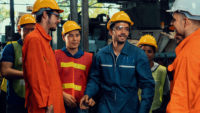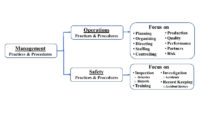The problems with safety management were discussed from a historic and program standards perspective in a prior article. A look at the management of safety may highlight how the traditional means and methods may have contributed to the ineffectiveness of the practice as well as the potential resulting undesirable outcomes. Some of this stems from how the enacted Occupational Safety and Health Act (standards) has been implemented by organizations as well as utilized in their operations.
Due to the fact that the OSHA standards were voluminous, covered a large number of potential hazardous conditions workers could be exposed to in the work environment, required a significant number of training sessions to be provided to workers in order to familiarize them with the standards, required postings, inspections, as well as reporting and record keeping; industry determined that this would have to be handled by someone other than their operational supervisors.
Operational staff were responsible for planning, organizing, directing, staffing, decision-making, problem solving, and controlling the production work as well as managing the risks associated with meeting contract obligations. The operational staff were responsible to produce the product, ensure the customer’s satisfaction, enhance the business goal of customer loyalty, as well as ensure profitability. They should not have to take on the additional specialized worker safety management responsibility.
Responsibility bifurcation
This effectively separated the oversight of worker safety from the organization’s operational activities. The project supervision and the operational staff are primarily responsible for the production of the work utilizing the project schedule to control and meet the contract obligations. They also had to manage any and all subcontractors to ensure meeting the contract expectations. The underlying shortcomings of this bifurcation will be covered in future articles. The safety function is primarily responsible to ensure work is performed in line with the company safety program.

As a result, the organization assigns management of worker safety to a knowledgeable person, or in some cases a department, to ensure that work is carried out in full compliance with the requirements and obligations of the OSHA standards. This means that the safety practitioner(s) became responsible to ensure that the physical condition where the workers were carrying out their work was free of physical hazards, that they were engaged in doing their work in accordance with the standards as well as performed their tasks in a safe manner and in such a way as to avoid getting injured.
The safety practitioner typically accomplishes this by making site visits checking for hazardous physical conditions which were then either corrected on the spot or brought to the attention of the supervisor in order to have it corrected expeditiously. But at the start of a “ground up” project there usually is only dirt and no structure, therefore there should be no physical hazards! So, if later on a physical hazard is encountered, then it had to be created by the previous work put in place. This then occurred under project staff supervision! So, before the next task is to start, project staff has the opportunity to address (remove) the hazard, or modify the next task’s procedures to minimize the risk. This proactively addresses risk rather than waiting for safety to come on site and reactively address the problem!
The other aspect of the inspection tour is to observe workers working and looking for any action or behavior that could result in an injury. This may require some observation time to identify potential unsafe behavior. Unsafe behavior or at-risk acts are then brought to the attention of the worker involved, and the applicable OSHA standard or safety program element are discussed and possibly a safer method may then be suggested so that the worker may proceed to work in a “safer” manner.
The modification of performance requires effort, and concentration, and it is easy to revert back to past practices. This requires observation for deviation and nudging the worker back to the corrected method. This may take some time which the safety person can do as they randomly make site visits. The supervisor who is there ‘all the time’ would be the logical person to perform the nudging. This highlights the problem that the functional separation of safety from operations presents.
The functional separation of safety from operations also tends to focus the bulk of the safety practitioner’s improvement interventions on the worker in order to improve safety outcomes. Generally, the traditional interventions have included primarily training or retraining the workers, greater emphasis on audits and inspections, stressing certain aspects of the program, making certain program areas a priority, rewriting or modifying safety program elements, incentive programs, enforcing disciplinary measures, or possibly getting someone fired. These interventions work to some extent, but eventually they all "plateau," and more importantly they almost never achieve lasting improved results.
Injury risk sources
It is a fact that construction is an industry in which workers suffer more accidents that result in injuries and/or fatalities than many of the others. According to the Bureau of Labor Statistics (BLS), workers suffer thousands of injuries and hundreds of fatalities on construction sites annually. The risks of injury at work could be attributed to:
- Bad luck
- The physical work environment being unsafe.
- Some deficiency on the part of the worker
- Due to shortcomings in the operational means & methods used.
The structural bifurcation of worker safety from operational management
Saying bad luck was the reason for an accident means that no one could have done anything in order to avoid having the unfortunate event occurring along with the resulting outcome. That is a copout and rather difficult to accept. In a previous article “Safety Management Challenges – History & Program Issues” published in ISHN in July 2022, we discussed two major studies of a large number of accidents. In the second one Frank Bird reviewed over 1,700,000 accidents and he found that about ninety five percent were attributable to employee action and about five percent were attributable to physical conditions. There were not any accidents found that were attributable to bad luck.
The existence of hazardous physical conditions and their prevalence will vary depending on the industry, organization to organization and jobsite to jobsite. Construction is a somewhat unique case. A building or structure under construction may possibly change its configuration or physical state on a daily basis because of new work being put in place. This may create situation where the physical state of the work may be hazardous to someone working in and around or traversing it. Those physical conditions encountered by people engaged in their tasks are generally created by work done by others previous to them. Then such exposures should have been identified and addressed by supervision before other workers are exposed to them.
The problem is that such physical hazards may also be the result of supervision’s work plans, selected means and methods, task assignment, matching of task demand with the worker’s capability, management’s production goals for the task or just a function of the work as it progresses. Another important factor is the fact that the safety practitioner may visit the job once a week or even once a month, and this means a lot of physical hazards and/or unsafe behavior is allowed to exit and continue without the implementation of corrective action.
As far as deficiency on the part of the worker is concerned, project supervision observes and interacts with the workforce and should have a pretty good idea of their knowledge, capability, and motivation. As a result, when making task assignment they should try to align the worker’s capabilities with the task demand. If they do not do that, they are increasing the risk of an accident occurring. We will address, point 4 & 5 above in the future as well as other possible factors that could and should be addressed in order to effectively manage occupational hazards, accidents and injuries.
So, if the safety practitioner is to find and address such hazardous physical exposure, they would have to be on site just about all the time, which is impractical. This would suggest that the project staff ought to pay attention to the potential risks integral to their selected means and methods and try to find ones with fewer embedded risks or devise ways to diminish their adverse effects. This also reinforces the notion that site safety should be the responsibility of supervisors as they are present on-site overseeing production operations, and know the workers’ capabilities.
Conclusion
It should be rather obvious that to effectively and holistically approach the problem of occupational accidents, injuries and fatalities need a major and complete review and assessment. Starting with the definition of safety. Safety is not a thing, it is a result, an outcome of actions. Safety is what you get if things are done properly and events go as planned. Accidents happen because things occur that prevent the task from proceeding as intended.
Fundamentally, the risk of accidents occurring is complex and multifaceted. To address it holistically everything must be evaluated starting with the standards and regulation, programs, polices, oversight, management, processes, inspections, metrics, procedures, education, training, communication, feedback as well as control. The management, oversight and control of safety must be the responsibility of operations, and the safety function ought to operate as a consultant to both preconstruction as well as construction operations.
Saying bad luck was the reason for an accident means that no one could have done anything in order to avoid having the unfortunate event occurring along with the resulting outcome. That is a copout and rather difficult to accept.



